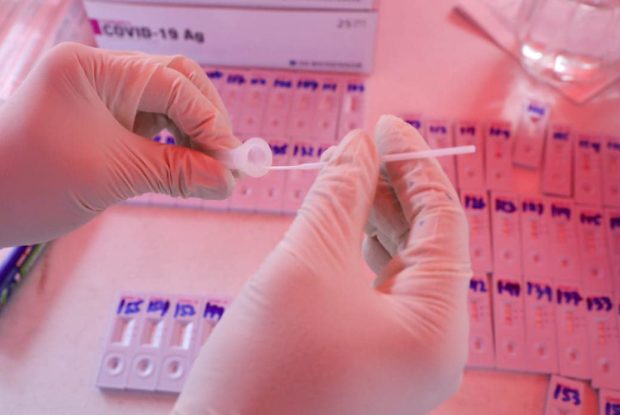
A health worker takes a swab test at a Swab Cab in Caloocan, a project of the Office of the Vice President. (File photo from the Facebook page of Vice President Leni Robredo)
MANILA, Philippines — More individuals in various areas in Luzon tested positive for the highly transmissible Omicron subvariants BA.5 and BA.2.12.1, based on the results of the latest genome sequencing run.
Of the 190 samples from the June 6 genome sequencing report, three cases were identified as BA.5, while seven were found to be of the BA.2.12.1 line.
Health Undersecretary Maria Rosario Vergeire said in an online briefing that two of the three individuals found with BA.5 were from Calabarzon, one of whom was fully vaccinated, while the other was not jabbed. The residence and vaccination status of the third case are still being verified.
Vergeire clarified that a couple who work in Pasay City and went to Marilao in Bulacan province to cast their votes on May 9 were the first two confirmed cases of BA.5. This brings to five the total BA.5 cases in the country.
Higher reproduction rate
Meanwhile, of the seven BA.2.12.1 cases, three were from Metro Manila, and the rest were from the regions of Ilocos, Cagayan Valley, Calabarzon, and Bicol. Three were fully vaccinated, three were not vaccinated, while the remaining individual’s status is still unknown.
Other details such as their health and recovery status are being gathered, Vergeire said.
The same data showed that the original Omicron variant B.1.1.529 remains the dominant strain in the country, with 104 cases, excluding the recently detected Omicron sublineages. There were 61 samples with no assigned lineage, while 14 were positive for the Delta variant.
Of the total Omicron samples, including those detected as sublineages, 103 were local cases, three were returning overseas Filipinos and the rest were still being verified.
The reproduction rate of COVID-19, which estimates the capacity of the virus to spread, moved up a notch to “high risk” in Metro Manila as new infections rose by a tenth in the first week of June, a pandemic monitor said on Tuesday.
Metro Manila at low risk
Based on the latest data from OCTA Research, Metro Manila posted a reproduction rate of 1.24 from May 31 to June 6, up from 1.06 from May 24 to May 30, which was at a “moderate risk” level. This means an infected person can transmit the virus to more than one individual on average.
The seven-day average of new cases climbed by 10 percent to 86 in the same period. The average attack rate (Adar), or the number of infected individuals per 100,000 population, also slightly increased to 0.61 on May 31 to June 6 from an Adar of 0.55 the previous week.
However, Metro Manila’s overall risk level remained “low” because the increased reproduction rate was offset by other metrics such as the positivity rate, health-care utilization rate and intensive care unit level, which were all classified as “very low risk.”
“National Capital Region remained at low risk amidst the uptick in new cases but the public is advised to not be complacent with health protocols,” OCTA Research fellow Guido David said.
The OCTA Research findings were consistent with the latest data from the Department of Health that showed a “slow increase” in new COVID-19 infections in Metro Manila.
RELATED STORIES
DOH posts 168 new COVID-19 cases; active at 2,437
Metro Manila’s COVID-19 reproduction number slightly up — Octa